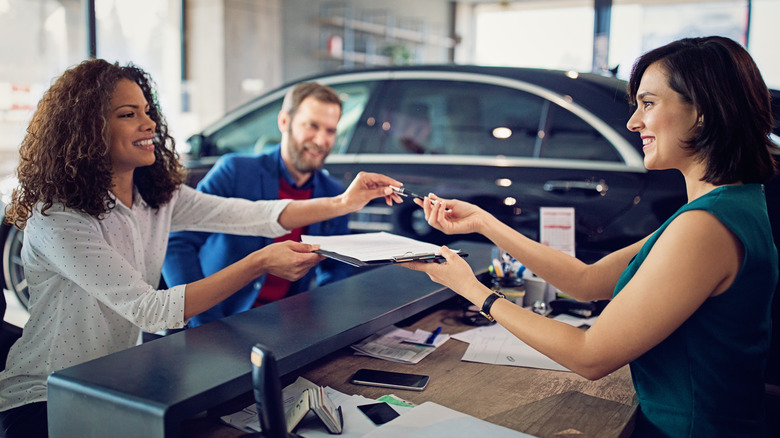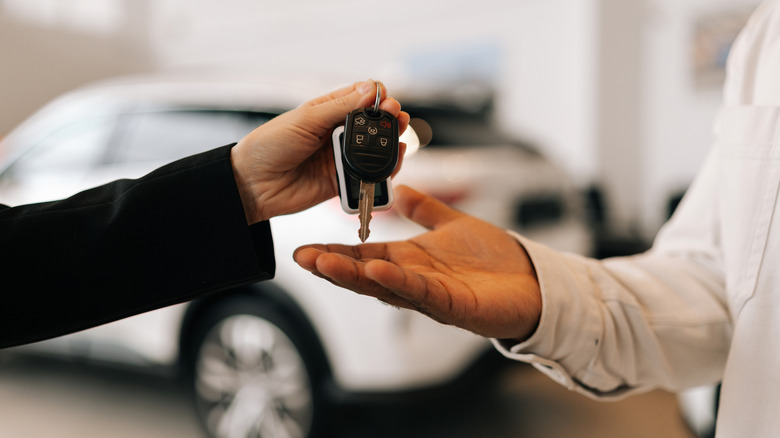Is It Cheaper To Lease Or Buy A Car?
When it comes time to get a new car, we're often faced with two competing options: lease or buy. For many of us, this means weighing the pros and cons of leasing versus financing a car, unless we're planning to pay cash for it. As it's often one of the biggest financial decisions we face as drivers, it's not one we take lightly. Leasing and buying a car achieve the same outcome: getting you behind the wheel. However, how you pay for your car and what you get for your money can be very different.
At first glance, leasing can seem like a very attractive option because of the lower upfront costs and monthly payments compared to financing a car. In fact, depending on the lease, you may find your payments are much lower than what you'd pay with a car loan, sometimes by several hundred dollars. That means you might be able to drive a more expensive car if you lease than you could if you financed the purchase.
The problem is, lower monthly payments don't always tell the whole story, and they certainly don't mean you're getting a better financial deal. When you buy a car, every payment you make helps you build equity. Once you've paid off the loan, you own the vehicle outright and can keep driving it without ever making another monthly payment. Buying a car also allows you to avoid things like the mileage limits and extra wear-and-tear charges that are often found in lease agreements. While leasing can sometimes feel cheaper month to month, buying may ultimately cost less in the long run, depending on how long you keep the car.
Leasing offers lower monthly payments but may cost more over time
If you're comparing leasing and buying the same vehicle, your monthly payments will almost always be cheaper if you lease. For example, monthly payments for leasing a 2025 Honda CR-V can start at around $378 per month for a 48-month term with very little due at signing. Finance that same vehicle over a 60-month loan term, and you could end up paying $626.93, depending on the interest rate and your down payment. Looking at these numbers, you might agree that leasing a vehicle is cheaper than buying it. However, there's a lot more to it than simply comparing monthly payments.
While these lower payments can make leasing more affordable in the short term, it's important to think about the bigger financial picture. When you lease, you don't own the car you're driving and don't build any equity. Once the lease term ends, you have to return the car to the dealership and have nothing to show for all of those monthly payments you made. When you lease a car, you'll often have to deal with mileage limits, typically ranging from 10,000 and 15,000 miles per year, and you may have to pay extra fees for any damage that's not considered normal wear and tear.
If something happens, and you need to get out of the lease early, you'll usually have to pay for that too. If you make a habit of leasing cars, you may find yourself in a cycle of never-ending monthly payments without ever owning a car. Over time, repeatedly leasing can become more expensive than buying and maintaining a car. However, if you like driving a new car every few years, leasing can make sense, even though it's not always the cheaper option in the long run.
Buying leads to ownership and potential long-term savings
Whether you buy a car outright or through financing, at some point, you know you're going to own the vehicle. While you'll most often have higher monthly payments than leasing, once you've paid off the loan, they come to an end. As the vehicle's owner, you're free to put as many miles on it as you'd like and modify it in whatever way you see fit.
Taking a look at recent data can help you get a sense of the total difference in cost. According to an AAA study, as of 2024, it costs around $12,297 a year to own a new car if you drive about 15,000 miles. This figure includes expenses like depreciation, loan interest, insurance, fuel, maintenance, and registration fees. In contrast, according to data from Experian, the average monthly payment for a leased vehicle in 2024 came to $638 or $7,656 per year and $22,968 over a three-year lease.
If we only look at the numbers, leasing seems like the cheapest option. However, when you buy a car, you build equity every time you make a payment, and once the loan is paid off, it's yours. And that's exactly where the long-term savings begin to add up. If you avoid the common maintenance mistakes that make your car less reliable, you could end up driving it for several years after you've paid it off. The longer you keep the car, the more you stretch your investment and avoid monthly payments altogether. While a new car loses value quickly in the first few years, depreciation tends to level off as more time passes. If you decide to sell the car later, you can recoup part of its value, something you can't do when you lease a vehicle.


